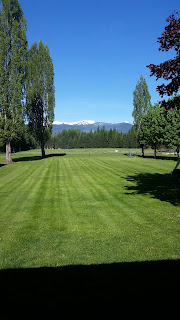
Though the rain was pouring down yesterday, the day prior was gorgeous. In this part of the world where the weather can change every five minutes from hail to sunshine, you learn to take advantage of it!
Sally, one of the desert horses that arrived to spend the summer with me had never seen trees, grass, wildlife, etc. before arriving at the farm. Though she's been settling in, everything in her world has changed.
As I was in-between my endless mowing and weed eating and spring chores, I saw a very different Sally standing out in the field. The horses were out grazing in the infield, a place she'd initially go nowhere near as the movement in the branches of the nearby trees due to the wind and wildlife had kept her on-guard eve in her opportunity for letting down.
As I go through my "checklist" of questions to owners with horses that arrive for training, one of the important ones is in regard to the horse's sleep patterns. Noticing if/when/how long the person actually sees the horse sleep.
Since arriving I'd seen Sally sleep, but not in a deep state and for very short periods of time, and only in the night time pastures. But this past week there was a big shift in her mentally. Simple, subtle moments where she'd offered on her own to be much more thoughtful, less emotionally reactive, and able to try in a reasonable manner.
I have found that the quality of the Conversation with the human affects the horse when they are on their own. And then I saw her... I'd turned out horses, but had to gently "re-direct" them to another pasture while they were loose. Sally had made a wrong turn into one area, I called her by name off the grass, she quit eating, came over to me, checked-in, then I pointed and I directed her to the correct pasture. She calmly walked off and resumed grazing. A few other horses had moved off further away, but she didn't engage. Even her body looked softer and more relaxed as she grazed.
And then a short while later, I watched her gently lie down, comfortably viewing the world around her, then settling-in as she took a nap. I headed over to say hi when she'd perked up again. Though she loved scratches for all her itchy spots when standing, she always had a tightness to her body, muscles, and breathing. But as I walked up at this moment, calling out to not startle her, she acknowledged me softly. I watched her, for any concern at my presence. There was none. So I came over and scratched on her and then took a seat.
Was this about capturing a fun picture? Not at all. This was an awesome moment in time that reflected the shift in her perception of the new world around her and me. This was a huge moment, for her to be completely "exposed" laying in the middle of a field, with a human nearby, and not have any fear or containment. This trust is what the equine partnership is built upon.
But it doesn't come from being "nice" to the horse, nor being "hopeful" in the communication. I had to present, and ask Sally to address many of her fears, anticipation, reactivity, and defensiveness in recent sessions. I had to offer her a safe place to express and purge her concern without critiquing her for feeling that way. I couldn't force anything to "happen" but I could offer every interaction to be a quality Conversation.
Does her trusting me as she lies down mean she is "finished?" No. But it is one of the many contributors that will and does affect Sally's journey to her becoming a thoughtful, willing, and confident equine.






 re-start. Besides addressing his pain and physical issues, I also need to re-educate him on the human experience.
re-start. Besides addressing his pain and physical issues, I also need to re-educate him on the human experience.













